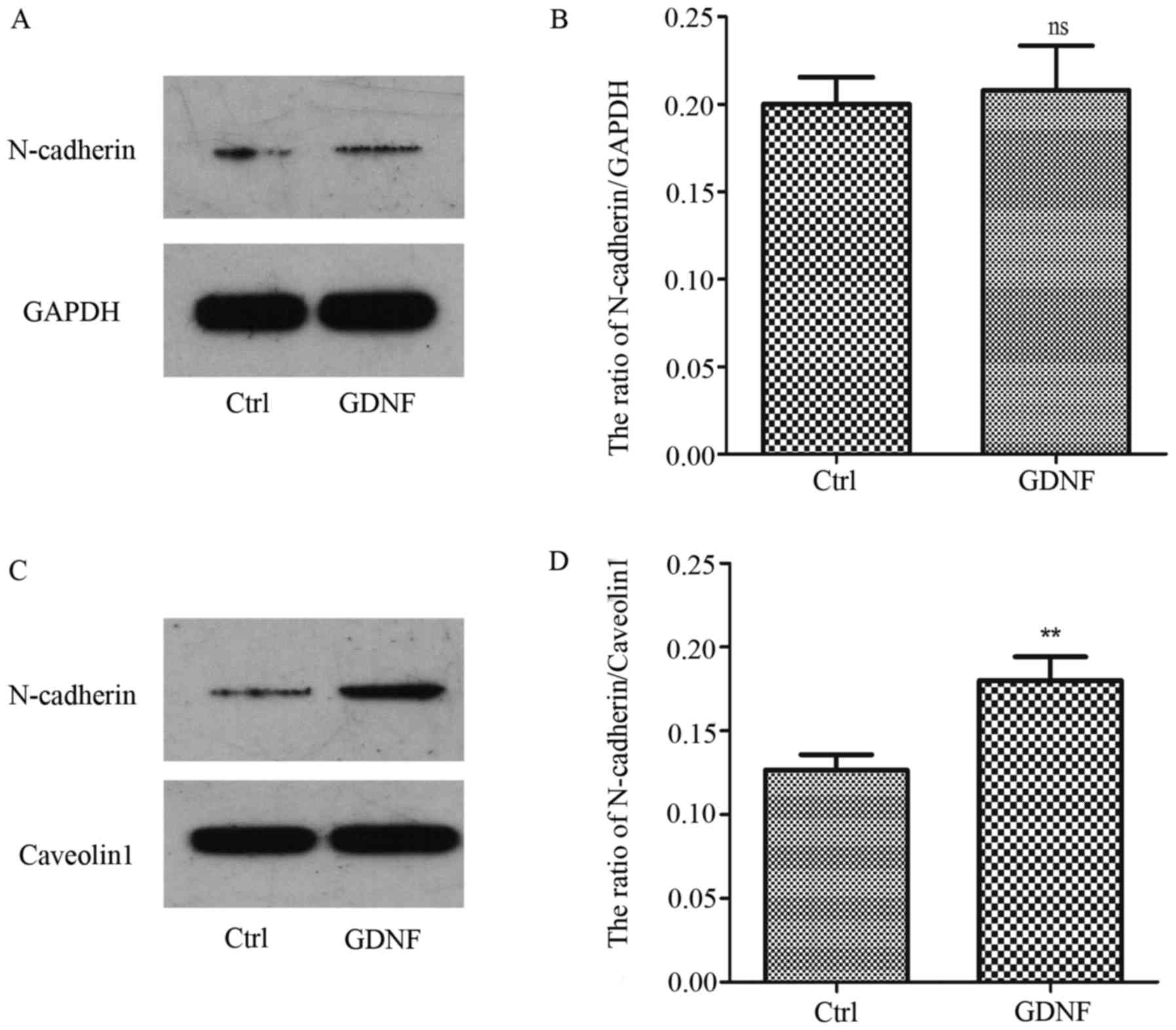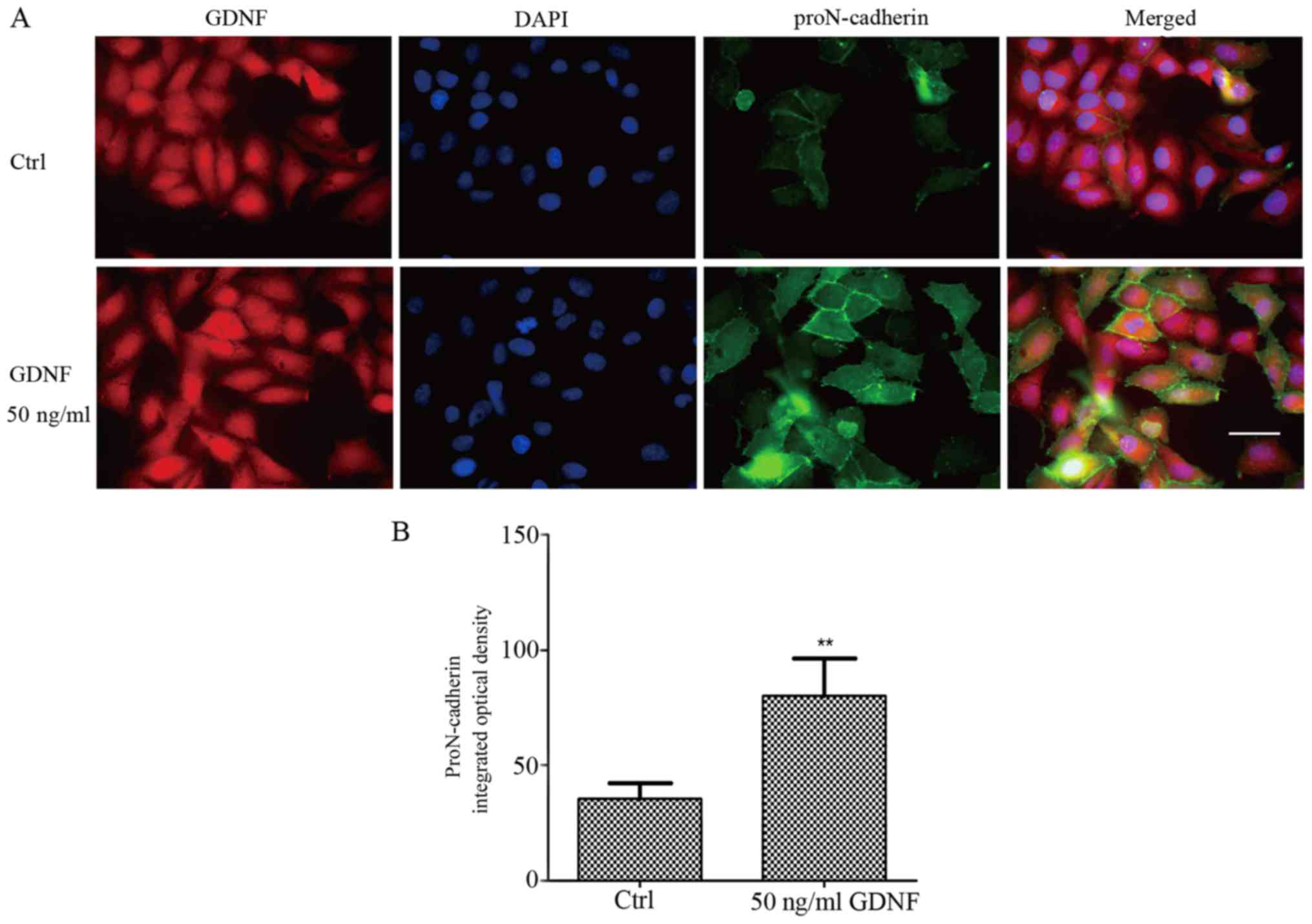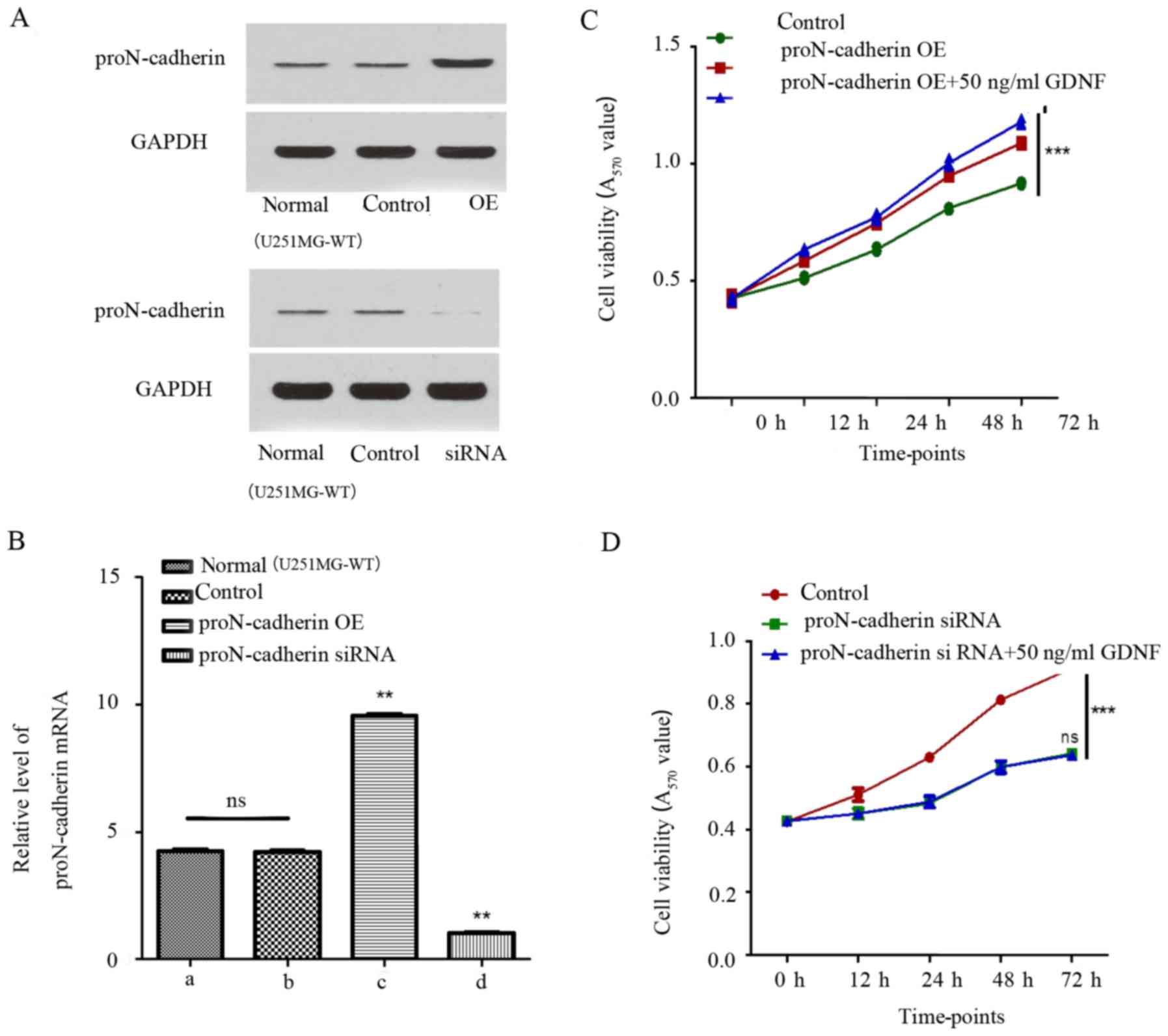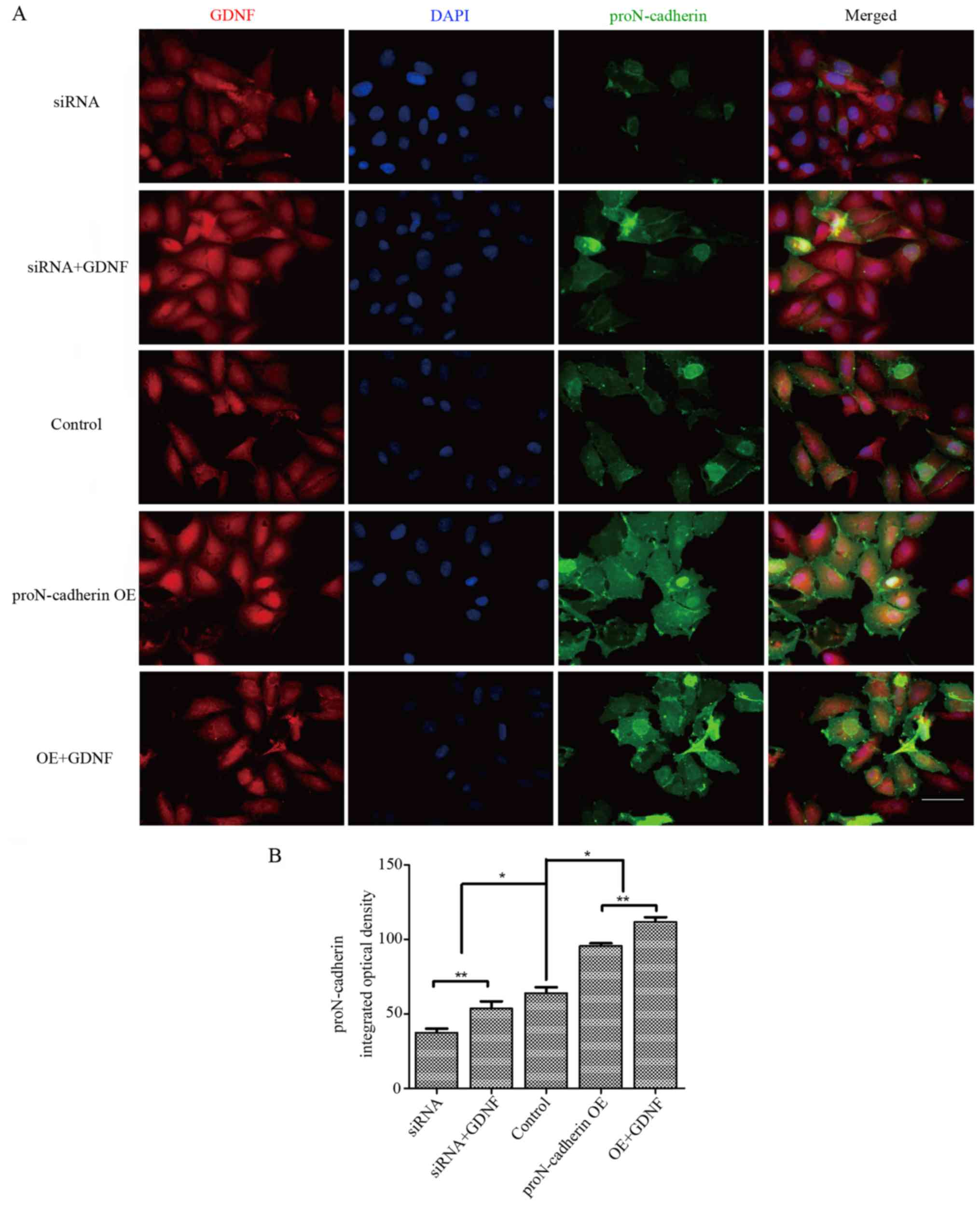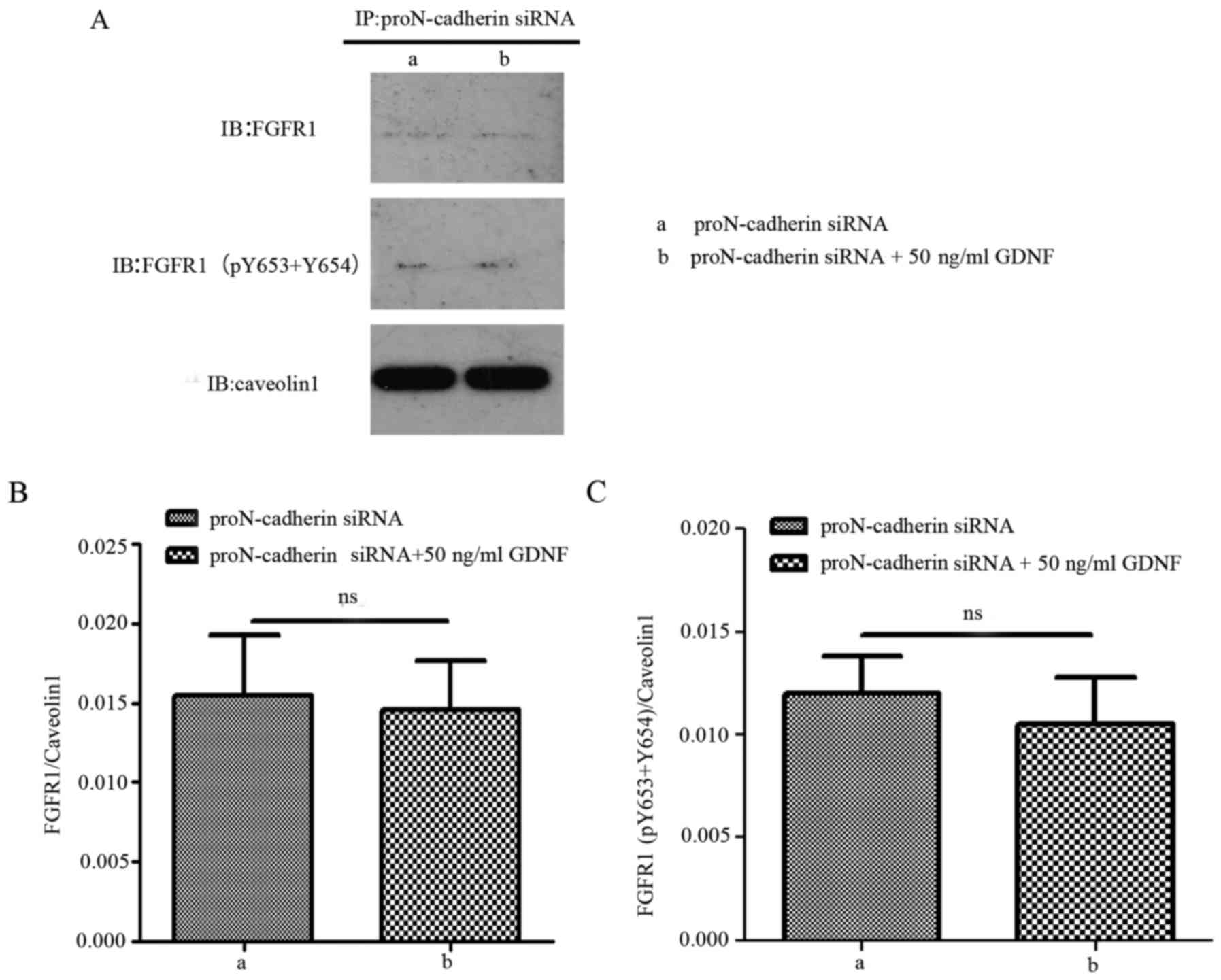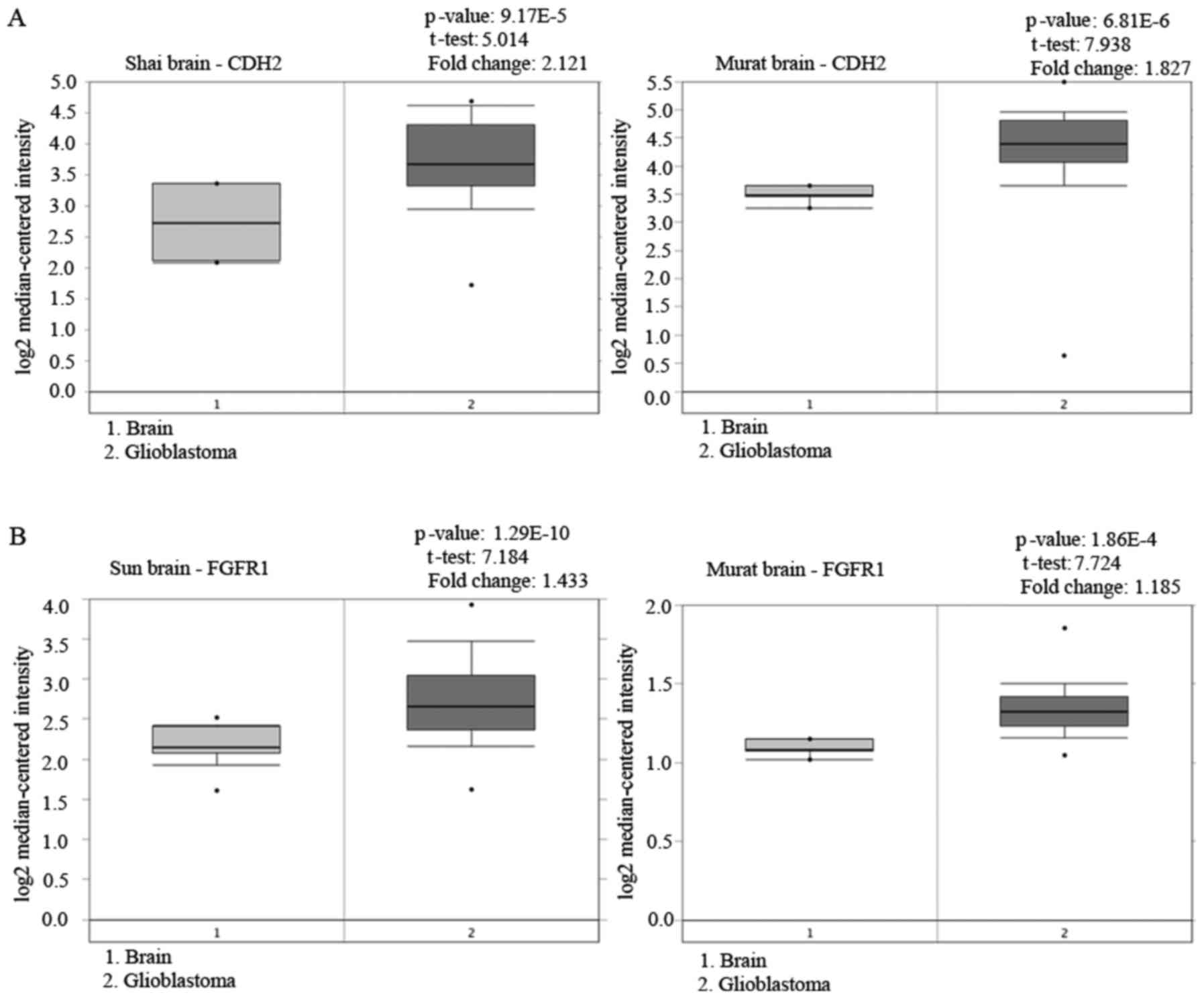Cross-link regulation of precursor N-cadherin and FGFR1 by GDNF increases U251MG cell viability
- Authors:
- Published online on: April 30, 2018 https://doi.org/10.3892/or.2018.6405
- Pages: 443-453
Abstract
Introduction
Glioblastoma, one of the most common primary brain tumors is the most lethal intracranial malignant tumor accounting for the majority of gliomas occurring in the human brain. Recent statistics report that approximately 20.59 per 100,000 patients were diagnosed each year in the United States between 2005–2009 (1). Glioblastoma is characterized by poor prognosis due to its biological characteristics of rapid proliferation, uncontrolled migration, infiltration, resistance to chemotherapy, as well as high recurrence even after surgical resection. Accumulating evidence shows that the basis of glioma migration and infiltration is often closely related to the excessive proliferation of cells. In recent years, a deeper understanding of the molecular mechanism underlying glioma development has led to the discovery of many molecular markers as indicators of clinical diagnosis and treatment. Among them are adhesion molecules involved in the migration and metastasis of gliomas (2), which are mostly clinically applied (3). However, little is known about the effect of adhesion molecules on the proliferation of tumor cells.
Cadherins are calcium-dependent cell adhesive glycoproteins which play important roles in regulating cell recognition, migration and tissue differentiation during embryonic development (4,5). N-cadherin as a classic member of cadherins is a homophilic transmembrane adhesion glycoprotein that is widely distributed in the central nervous system, especially in neurons and glial cells (2). In a variety of tumors, the abnormal expression of N-cadherin enhances cell activity and invasive ability (6) such as in breast (7), prostate (8) and bladder cancer (9). Similarly, the expression of N-cadherin in glioma tissues is significantly higher compared with normal brain tissues (10). Maret et al (11) reported that the precursors of N-cadherin (proN-cadherin) and N-cadherin were present on the cell membrane and the proportion of precursors on the tumor cells was higher (11). Our previous study doubted recent studies on N-cadherin, criticizing that these studies were actually about precursors of N-cadherin, and we demonstrated that GDNF can promote the adhesion of glioma cells to the matrix by promoting the expression of proN-cadherin in glioma cells, which successively amplified the process of migration and invasion (2).
Glial cell-line derived neurotrophic factor (GDNF), a member of the transforming growth factor-β (TGF-β) superfamily, is a soluble extracellular factor initially found to be a protective factor for the survival and differentiation of dopaminergic neurons (12). GDNF plays important roles in neuronal survival, growth, differentiation and migration (13,14). However, it has been reported to be strongly expressed in human gliomas (15). During neurogenesis, GDNF regulates cell differentiation and organ formation by promoting self-renewal and proliferation of stem cells (12,16,17). In our previous studies, we reported that GDNF was abnormally highly expressed in glioma tissues and we suggested that high concentration of GDNF promoted glioma development (2,18). Since the specific mechanisms underlying glioma development are constantly updated, GDNF has been identified as a major force of attraction and has being studied extensively regarding its roles in gliomas. One of these studies reported that GDNF could directly stimulate the membrane receptor-Neuropilin-1 (19), and activate proliferation-related signaling pathways, however, it is unknown whether GDNF can indirectly activate other growth factor-related receptors. Furthermore, it has been reported that GDNF can bind with the adhesion molecule NCAM and RET on the cell membrane as a co-receptor transduction signal to regulate the growth and migration of Schwann neurons (20).
In addition, this study revealed that GDNF indirectly stimulated other family receptors on the cell membrane and strengthened their signal transduction processes, hence promoting the growth and proliferation of glioblastoma cells. This is a relatively new and original viewpoint, which indicates a new direction for research on the relationship between adhesion molecules and membrane receptors.
Materials and methods
Cell culture and transfection
The human malignant glioma cell line U251MG was obtained from the Shanghai Institute of Biological Sciences (Shanghai, China). It was verified that the cells we used matched the profile of U251MG cells. The cells were cultured in Dulbecco's modified Eagle's medium (DMEM; HyClone Laboratories, Logan, UT, USA), supplemented with 10% fetal bovine serum (FBS; HyClone Laboratories) and 0.1% penicillin-streptomycin at 37°C in a humidified 5% CO2 atmosphere. According to the experimental protocol, the cells were treated with human GDNF (50 ng/ml; Gibco; Thermo Fisher Scientific, Inc., Waltham, MA, USA) for 30 min, while untreated cells were left in medium (control).
The EF1A-proN-cadherin-IRES-EGFP and vector plasmids were constructed based on the proN-cadherin sequence [(National Center for Biotechnology Information (NCBI) reference sequence: BC036470.1]. In addition, we also designed a highly effective small interfering RNA (siRNA) plasmid and one negative control RNAi vector plasmid. The target sequence of proN-cadherin siRNA and the control were as follows: siRNA-sense, (5′-3′) GUGCAGUCUUAUCGAAG GATT and antisense (5′-3′) UCCUUCGAUAAGACUGCA CTT; control sense, (5′-3′) UUCUC CGAACGUGUCACGUTT and antisense, (5′-3′) ACGUGACACGUUCGGAGAATT.
The proN-cadherin overexpression plasmid and siRNA with their respective control plasmids were transfected into serum-starved U251MG cells for 24 h by Lipofectamine 2000 (Invitrogen; Thermo Fisher Scientific, Inc.), continuously cultured in 6-well plates.
Cell viability assays
The U251MG cells from different groups were seeded into 96-well plates at a density of 1×104 cells/well. The first MTT assay was performed after 12 h when the cells had grown to 50% confluency. The above-mentioned results were regarded as starting value (0 h). Concurrently, we treated cells with GDNF 50 ng/ml for 30 min according to the experimental grouping protocol.
At different indicated time-points, MTT solution was added to the wells and incubated for 4 h at 37°C. Subsequently, the supernatant was discarded and 150 µl dimethylsulfoxide (DMSO) per well was added. The optical density was assessed with a microplate reader at a wavelength of 570 nm.
Co-immunoprecipitation and western blot analysis
U251MG cell membrane protein was extracted using an eukaryotic membrane protein extraction kit (ProteoExtract™, M-PEK; Merck KGaA, Darmstadt, Germany). The primary anti-proN-cadherin antibody (GTX101141; GeneTex, Irvine, CA, USA) and protein A/G agarose (sc-2003; Santa Cruz Biotechnology, Santa Cruz, CA, USA) for immunoprecipitation were added into the lysates with the membrane protein at 4°C overnight on a low-speed rotating shaker. The beads were washed three times with lysis buffer and boiled in 1X SDS loading buffer to elute the antibody bound protein. SDS-PAGE gels (10%) were used to separate samples and polyvinylidene fluoride (PVDF) membranes were used to transfer the protein blots. Membranes were blocked with 5% skimmed milk, washed and incubated with primary antibody [rabbit anti-FGFR1, 1:1,000; mouse anti-FGFR1 (pY653+pY654), 1:1,000] at 4°C overnight. The membranes were incubated with IRdye secondary antibodies (goat anti-rabbit; 1:10,000; cat. no. 92632211; goat anti-mouse; 1:10,000; cat. no. 92632210; LI-COR Biosciences, Lincoln, NE, USA) and scanned by an Odyssey imaging system (LI-COR Biosciences). In addition, total protein from U251MG cells was extracted by RIPA lysis buffer (Nanjing KeyGen Biotech, Co., Ltd., Nanjing, China) containing a mixture of protease inhibitors.
U251MG cells were divided into 8 groups as follows: normal, normal with 50 ng/ml GDNF, overexpression proN-cadherin with or without 50 ng/ml GDNF treated for 30 min, the control plasmid group, proN-cadherin siRNA with or without 50 ng/ml GDNF treated for 30 min. Prior to this study, we had applied three types of siRNA to verify the downregulation of proN-cadherin. The type used in the present study could realize the downregulation of proN-cadherin and ensure cell survival without considerable cytotoxicity. The siRNA sequences were based on the 477 bp sequence (pro-domain) on the N-terminal of proN-cadherin mRNA (ref. seq., BC036470.1). After blocking by 5% skimmed milk, the samples were incubated with primary antibody (rabbit anti-proN-cadherin antibody; 1:1,000; cat. no. GTX101141; GeneTex; mouse anti-GAPDH antibody; 1:1,000; cat. no. sc-365062; Santa Cruz Biotechnology; rabbit anti-caveolin1, 1:1,000; cat. no. ab17052; Abcam) at 4°C overnight. Then, the samples were incubated with IRdye secondary antibodies (goat anti-rabbit, 1:1,000; goat anti-mouse, 1:1,000; LI-COR Biosciences) at room temperature for 2h. Finally, the protein bands were scanned by Odyssey imaging system (LI-COR Biosciences) and quantifed with ImageJ software (National Institutes of Health, Bethesda, MD, USA).
Immunofluorescence assay
Coverslips were put into 24-well plates as U251MG cells were seeded into different wells and cultured for 24 h. Cells were then monitored until 50% confluent and treated with GDNF 50 ng/ml for 30 min. Subsequently, cells were washed with PBS three times, followed by fixation for 30 min at room temperature in 4% paraformaldehyde. Fixed cells were permeabilized for 5 min at room temperature using 0.3% Triton X-100 and blocked for 30 min using 5% goat serum diluted with PBS. Furthermore, the samples were incubated with GDNF antibody (rabbit anti-GDNF, 1:250; cat. no. ab18956; Abcam) overnight at 4°C, followed by a series of washing with PBS and finally incubation with secondary antibody: goat anti-rabbit IgG (H+L)-DyLight 594 (1:1,000; EarthOx Life Sciences, Millbrae, CA, USA) for 2 h in the dark and 4′6-diamidino-2-phenylindole (DAPI). Successively, cells were stained by proN-cadherin antibody (rabbit anti-proN-cadherin antibody, 1:250; cat. no. GTX101141; GeneTex) and incubated with goat anti-rabbit IgG (H+L)-DyLight 488 (at 1:1,000; EarthOx Life Sciences). Fluorescence images were captured with a fluorescent inverted microscope (Leica Microsystems, Wetzlar, Germany).
Real-time quantitative PCR
Total RNA was extracted by TRIzol reagent (15596-026; Invitrogen) and the first-strand cDNA was synthesized by RevertAidTM H Minus First Strand cDNA Synthesis kit (K1631; Fermentas; Thermo Fisher Scientific, Inc.), followed by qPCR using the SYBR-Green PCR Master Mix (ABI 4309155; Applied Biosystems; Thermo Fisher Scientific). qPCR conditions were as follows: 5 min at 95°C; 20 sec at 94°C, 20 sec at 61°C and 20 sec at 72°C for 40 cycles followed by 72°C for 5 min. The above procedure was implemented on the Real-Time-PCR system (ABI 7900). β-actin was used as a reference gene and qRT-PCR was performed in triplicates for each sample. The relative expression level of target genes was calculated by the 2−∆∆Ct method. Upstream and downstream primer sequences for the amplification of the target gene and internal reference are listed in Table I.
Statistical analysis
The quantitative data were presented as the mean ± standard deviation (SD) of two independent experiments and analyzed by the Student's t-test. Multiple comparisons between groups were performed using one-way analysis of variance followed by the Student-Newman-Keuls test for statistical analysis. Statistical analyses were performed using SPSS version 19.0 (IBM Corp., Armonk, NY, USA). For all statistical analyses, P<0.05 was considered to indicate a statistically significant difference.
Results
GDNF amplifies the expression of proN-cadherin and promotes U251MG cell viability
The proN-cadherin and N-cadherin expression level were evaluated in U251MG cells treated with or without 50 ng/ml GDNF for 30 min, comparing both the membrane and the cytoplasm proteins. As displayed in Fig. 1A and B proN-cadherin was mainly expressed on the cell membrane and GDNF enhanced the expression level of proN-cadherin in both the cytoplasm and the cell membrane. However, the level of N-cadherin in the membrane was obviously increased with GDNF treatment. Concurrently, we observed that the N-cadherin level in the cytoplasm was almost not changed (Fig. 2).
Concurrently, we analyzed the proliferative effects of GDNF on the U251MG cells using an MTT assay. The results revealed that GDNF promoted the viability of U251MG cells in a significant manner (Fig. 1C).
In our previous study, proN-cadherin was reported to be abundantly present in the cytomembrane and could interact with GDNF (2). As displayed in Fig. 1, we confirmed that proN-cadherin was mainly expressed in the cytomembrane, however, the percentage of proN-cadherin in the cytoplasm was extremely low. To further validate these results, we performed immunofluorescence (IF) experiments to localize the protein expression within the cells. The fluorescence intensity of proN-cadherin was significantly higher in U251MG cells with 50 ng/ml GDNF than in cells without GDNF (Fig. 3). This finding indicated that proN-cadherin was more abundant in the membrane of U251MG cells due to the high expression of GDNF in the cells.
GDNF promotes proN-cadherin-induced viability of U251MG cells
Since the relationship between proN-cadherin and cell viability was unclear, the expression of proN-cadherin was altered by constructing plasmids to overexpress proN-cadherin and proN-cadherin siRNA to implement the variation of protein and mRNA expression level. ProN-cadherin protein and mRNA expression was verified by western blot analysis and qPCR respectively in samples from transfected and untransfected cells (Fig. 4A and B). Consequently, while comparing the control group with the proN-cadherin overexpressed group using the MTT assay, we observed an obviously increased rate of cell viability in the proN-cadherin OE group (Fig. 4C). Notably, proN-cadherin OE group with exogenous GDNF facilitated cell viability more obviously. Furthermore, siRNA of proN-cadherin reduced the rate of cell viability. The viability could not be improved despite treatment with 50 ng/ml GDNF, which indicated that it was more difficult for GDNF to play a role in promoting the cell viability under the low proN-cadherin expression state (Fig. 4D). Detailed measurement data are listed in Tables II and III.
Table II.The OD570-difference comparison between proN-cadherin OE and control groups at different time-points (mean ± SD, n=3). |
Table III.The OD570-difference comparison between proN-cadherin siRNA and control groups at different time-points (mean ± SD, n=3). |
Based on these results we concluded that the increasing level of proN-cadherin on the membrane of U251MG cells improved the ability of cell viability to a considerable extent. In addition, the synergistic effect of GDNF and proN-cadherin would reinforce its effect on cell viability. To identify changes in the orientation and expression level of proN-cadherin, we provided morphological evidence by performing immunofluorescence assay. In the overexpression group with 50 ng/ml GDNF, the integrated optical density of proN-cadherin was higher than in other groups (P<0.05) (Fig. 5) and it was clearly observed that proN-cadherin on the cell membrane was significantly increased under the effect of GDNF whether in the siRNA or in the proN-cadherin OE group.
GDNF increases the phosphorylation level of FGFR1 and strengthens proN-cadherin and FGFR1 (pY653+Y654) interaction on the cell membrane
Subsequently, we explored how GDNF-induced proN-cadherin activation in the cell membrane exerts a role in regulating cell viability. Caveolin 1 was used as a suitable reference of the membrane protein, and we observed that the phosphorylation level of FGFR1(pY653+pY654) increased significantly (Fig. 6). Although the expression of FGFR1 was slightly enhanced by GDNF, the increasing ratio of phosphorylated FGFR1 was still greater. After immunoprecipitation protein spectrum analysis, we observed that FGFR1 interacted with proN-cadherin. Furthermore, we examined two phosphorylation sites on FGFR1 (Y653 and Y654). The conclusion of GDNF interacting with proN-cadherin has been demonstrated in our previous study (2), but the interaction between proN-cadherin and FGFR1 was reported in the present study for the first time. We speculated that the potential mechanism employed by GDNF-induced proN-cadherin interaction with FGFR1 was an effort to improve signal transmission and cell viability. Under the influence of exogenous GDNF, the combining amount of these two membrane proteins would be enhanced, especially the interaction between the phosphorylated FGFR1 and proN-cadherin (Fig. 7). When proN-cadherin was downregulated, there was no significant change observed in the interaction between proN-cadherin and FGFR1/FGFR1 (pY653+pY654) regardless of the presence or absence of GDNF (Fig. 8). These results indicated that the presence of proN-cadherin was vital for this process.
The above-mentioned results indicated that proN-cadherin interacted with FGFR1/FGFR1 (pY653+pY654) and this combined capacity could be enhanced by exogenous GDNF treatment and the high expression of membrane proN-cadherin protein. However, once proN-cadherin protein was downregulated on the cell membrane, GDNF would not play a role in promoting interactions between these two proteins. For further speculation, the proliferative effects may not be realized without GDNF mediating the connection between proN-cadherin and FGFR1.
Discussion
We have previously reported that GDNF exhibited protective effects on dopaminergic neurons by interacting with transmembrane proteins such as integrin β1 (21), NCAM (22) and N-cadherin (23). Furthermore, according to a previous study GDNF was approximately five times more highly expressed in human malignant gliomas compared to normal human brain tissues (15). Based on these data, we recently reported the interactions between GDNF and precursors N-cadherin by molecular docking analysis, co-immunoprecipitation and immunofluorescence analysis, and provided evidence that GDNF interacted with five AA residues in the EC3 region of proN-cadherins (2).
In the present study, we presented stronger evidence to support our recent study on the proN-cadherin expression (2) with data from the Oncomine database (http://www.oncomine.org) acknowledging the expression of N-cadherin in glioblastoma tissue samples (Fig. 9A). Concurrently, we observed that GDNF could promote the expression of proN-cadherin on the cell membrane as well as glioma cell viability. Accumulating evidence indicated that GDNF could directly mediate signal transduction via membrane receptors to regulate gliomas cell viability. However, the present study focused on the interaction among proN-cadherin and other receptors mediated by GDNF, which would enhance cell viability indirectly. We observed the changes in cell viability on the basis of knockdown and overexpression of proN-cadherin complemented with the exogenous GDNF. Furthermore, the relationship between proN-cadherin and FGFR1 receptor on the membrane was demonstrated, where proN-cadherin was more likely to bind to phosphorylated FGFR1. Based on the analysis of the results, we concluded that both overexpression of proN-cadherin and exogenous GDNF promoted U251MG cell viability and if these two parameters were achieved combined, cell viability would be more obvious.
Fibroblast growth factors (FGF) are a family of ligands that bind to four different types of cell surface receptors (FGFR1, FGFR2, FGFR3 and FGFR4) (24). FGF ligand binding to the FGFR caused receptor dimerization, transphosphorylation and activation of an intracellular tyrosine kinase domain (25). FGFR1 binds to the ligand FGF to activate the PI3K-AKT, IP3-PLC/DAG, JAK-STAT (26) and other signaling pathways which regulate cell self-renewal, metabolism, proliferation, EMT and angiogenesis (27,28). Recent studies revealed that the FGFR family, especially FGFR1, was abnormally highly expressed in a variety of tumor tissues like prostate, pancreatic and cervical cancer, as well as gliomas (29) (Fig. 9B). Xian et al (30) reported that abnormal expression of FGFR1 activated the downstream ERK pathway and significantly promoted the proliferation of epithelial cells of breast cancer (30). Furthermore, FGFR1-mediated signaling pathways are known to modulate key cellular activities like proliferation, differentiation and survival (25,31). The phosphorylation of tyrosine 653 and tyrosine 654 in the FGFR1 leads to a large conformational change in the activated portion of the FGFR1. In addition, pY653 and pY654 interacted with surrounding residues favorably. Further studies revealed that the phosphorylation of Y653 and Y654 in FGFR1 would facilitate the binding of the receptor to the phospholipase Cγ through the SH2 domain, which is more favorable for downstream signaling activation (32). In this study, GDNF promoted the expression of proN-cadherin on the glioma cell membrane. GDNF was linked to proN-cadherin, which enhanced cell to cell interaction, however, overexpression of proN-cadherin promoted the phosphorylation of FGFR1 and the interaction between these two proteins was enhanced under the influence of exogenous GDNF. Therefore, we proposed that GDNF indirectly activated the FGFR1 receptor and modulated the relationship between proN-cadherin and FGFR1 synergistically to stimulate the signal transduction pathway involved in glioma cell viability.
In conclusion, we elucidated a potential GDNF mechanism of action in promoting glioma cell viability. The development of gliomas may be through the cross-linking effect of membrane adhesion molecules and growth factor receptor family prompted by GDNF, thereby increasing the degree of activation of the growth factor receptors, which helped signal transduction and prolonged the response time of FGF-FGFR. The interaction of FGFR1 and proN-cadherin was enhanced by GDNF stimulation and phosphorylation of FGFR1 was increased. Subsequently, sustained activation of FGFR1 would undoubtedly activate the downstream signal pathway, which would explain the cell viability. This mechanism may offer a new perspective. Concurrently, we proposed that this new viewpoint concerning the correlation of adhesion molecules and membrane signaling receptors, would provide new insights in the field of signal transduction research. In addition, whether proN-cadherin of adjacent cells activated FGFR1 in other cells remained undetermined. The present study set a new precedence for studies on cell-cell communication since it revealed that resistance to proN-cadherin cross-linking with FGFR1 may provide a new perspective for cancer therapeutic treatment.
Acknowledgements
We wish to thank the Neurobiology Research Center of Xuzhou Medical University for providing the research platform. We would like to express our deep gratitude to the research team. CXT also expresses his thanks to Miss Chun Yan Mu for her encouragement and spiritual support.
Funding
The present study was funded by the National Natural Science Research Fundation of China (grant nos. 81372698 and 81402918) and the Natural Science Foundation of Jiangsu Province, China (BK20140228).
Availability of data and material
All data generated or analyzed during the present study are available from the corresponding author upon reasonable request.
Authors' contributions
CXT conceived and designed the study, conducted the project administration, the drafting and submission of the manuscript. YXG performed the majority of the experiments and data collection. XFL performed most experiments, data analysis and literature search. SYT assisted in the experiments. AAA assisted in the experiments and offered critical review of the manuscript. YG performed the statistical analysis and data processing. GQJ organized the images and tables. YX conducted the experiment guidance. LYH received funding and conducted experiment guidance. DSG received funding and contributed in the project supervision, study conception and design. All authors read and approved the manuscript and agree to be accountable for all aspects of the research in ensuring that the accuracy or integrity of any part of the work are appropriately investigated and resolved.
Ethics approval and consent to participate
Not applicable.
Consent for publication
Not applicable.
Competing interests
The authors declare that they have no competing interests.
References
|
Dolecek TA, Propp JM, Stroup NE and Kruchko C: CBTRUS statistical report: Primary brain and central nervous system tumors diagnosed in the United States in 2005–2009. Neuro Oncol. 14 Suppl 5:v1–v49. 2012. View Article : Google Scholar : PubMed/NCBI | |
|
Xiong Y, Liu L, Zhu S, Zhang B, Qin Y, Yao R, Zhou H and Gao DS: Precursor N-cadherin mediates glial cell line-derived neurotrophic factor-promoted human malignant glioma. Oncotarget. 8:24902–24914. 2017.PubMed/NCBI | |
|
Kourtidis A, Lu R, Pence LJ and Anastasiadis PZ: A central role for cadherin signaling in cancer. Exp Cell Res. 358:78–85. 2017. View Article : Google Scholar : PubMed/NCBI | |
|
Halbleib JM and Nelson WJ: Cadherins in development: Cell adhesion, sorting, and tissue morphogenesis. Genes Dev. 20:3199–3214. 2006. View Article : Google Scholar : PubMed/NCBI | |
|
Goodwin M and Yap AS: Classical cadherin adhesion molecules: Coordinating cell adhesion, signaling and the cytoskeleton. J Mol Histol. 35:839–844. 2004. View Article : Google Scholar : PubMed/NCBI | |
|
Rosivatz E, Becker I, Bamba M, Schott C, Diebold J, Mayr D, Höfler H and Becker KF: Neoexpression of N-cadherin in E-cadherin positive colon cancers. Int J Cancer. 111:711–719. 2004. View Article : Google Scholar : PubMed/NCBI | |
|
Han AC, Soler AP, Knudsen KA and Salazar H: Distinct cadherin profiles in special variant carcinomas and other tumors of the breast. Hum Pathol. 30:1035–1039. 1999. View Article : Google Scholar : PubMed/NCBI | |
|
Tomita K, van Bokhoven A, van Leenders GJ, Ruijter ET, Jansen CF, Bussemakers MJ and Schalken JA: Cadherin switching in human prostate cancer progression. Cancer Res. 60:3650–3654. 2000.PubMed/NCBI | |
|
Giroldi LA, Bringuier PP, Shimazui T, Jansen K and Schalken JA: Changes in cadherin-catenin complexes in the progression of human bladder carcinoma. Int J Cancer. 82:70–76. 1999. View Article : Google Scholar : PubMed/NCBI | |
|
Asano K, Duntsch CD, Zhou Q, Weimar JD, Bordelon D, Robertson JH and Pourmotabbed T: Correlation of N-cadherin expression in high grade gliomas with tissue invasion. J Neurooncol. 70:3–15. 2004. View Article : Google Scholar : PubMed/NCBI | |
|
Maret D, Gruzglin E, Sadr MS, Siu V, Shan W, Koch AW, Seidah NG, Del Maestro RF and Colman DR: Surface expression of precursor N-cadherin promotes tumor cell invasion. Neoplasia. 12:1066–1080. 2010. View Article : Google Scholar : PubMed/NCBI | |
|
Lin LF, Doherty DH, Lile JD, Bektesh S and Collins F: GDNF: A glial cell line-derived neurotrophic factor for midbrain dopaminergic neurons. Science. 260:1130–1132. 1993. View Article : Google Scholar : PubMed/NCBI | |
|
Sariola H and Saarma M: Novel functions and signalling pathways for GDNF. J Cell Sci. 116:3855–3862. 2003. View Article : Google Scholar : PubMed/NCBI | |
|
Airaksinen MS and Saarma M: The GDNF family: Signalling, biological functions and therapeutic value. Nat Rev Neurosci. 3:383–394. 2002. View Article : Google Scholar : PubMed/NCBI | |
|
Wiesenhofer B, Stockhammer G, Kostron H, Maier H, Hinterhuber H and Humpel C: Glial cell line-derived neurotrophic factor (GDNF) and its receptor (GFR-alpha 1) are strongly expressed in human gliomas. Acta Neuropathol. 99:131–137. 2000. View Article : Google Scholar : PubMed/NCBI | |
|
Sainio K, Suvanto P, Davies J, Wartiovaara J, Wartiovaara K, Saarma M, Arumäe U, Meng X, Lindahl M, Pachnis V, et al: Glial-cell-line-derived neurotrophic factor is required for bud initiation from ureteric epithelium. Development. 124:4077–4087. 1997.PubMed/NCBI | |
|
Meng X, Lindahl M, Hyvönen ME, Parvinen M, de Rooij DG, Hess MW, Raatikainen-Ahokas A, Sainio K, Rauvala H, Lakso M, et al: Regulation of cell fate decision of undifferentiated spermatogonia by GDNF. Science. 287:1489–1493. 2000. View Article : Google Scholar : PubMed/NCBI | |
|
Zhang BL, Guo TW, Gao LL, Ji GQ, Gu XH, Shao YQ, Yao RQ and Gao DS: Egr-1 and RNA POL II facilitate glioma cell GDNF transcription induced by histone hyperacetylation in promoter II. Oncotarget. 8:45105–45116. 2017.PubMed/NCBI | |
|
Sun S, Lei Y, Li Q, Wu Y, Zhang L, Mu PP, Ji GQ, Tang CX, Wang YQ, Gao J, et al: Neuropilin-1 is a glial cell line-derived neurotrophic factor receptor in glioblastoma. Oncotarget. 8:74019–74035. 2017.PubMed/NCBI | |
|
Paratcha G, Ledda F and Ibáñez CF: The neural cell adhesion molecule NCAM is an alternative signaling receptor for GDNF family ligands. Cell. 113:867–879. 2003. View Article : Google Scholar : PubMed/NCBI | |
|
Cao JP, Wang HJ, Yu JK, Yang H, Xiao CH and Gao DS: Involvement of NCAM in the effects of GDNF on the neurite outgrowth in the dopamine neurons. Neurosci Res. 61:390–397. 2008. View Article : Google Scholar : PubMed/NCBI | |
|
Cao JP, Yu JK, Li C, Sun Y, Yuan HH, Wang HJ and Gao DS: Integrin beta1 is involved in the signaling of glial cell line-derived neurotrophic factor. J Comp Neurol. 509:203–210. 2008. View Article : Google Scholar : PubMed/NCBI | |
|
Zuo T, Qin JY, Chen J, Shi Z, Liu M, Gao X and Gao D: Involvement of N-cadherin in the protective effect of glial cell line-derived neurotrophic factor on dopaminergic neuron damage. Int J Mol Med. 31:561–568. 2013. View Article : Google Scholar : PubMed/NCBI | |
|
Jaye M, Schlessinger J and Dionne CA: Fibroblast growth factor receptor tyrosine kinases: Molecular analysis and signal transduction. Biochim Biophys Acta. 1135:185–199. 1992. View Article : Google Scholar : PubMed/NCBI | |
|
Turner N and Grose R: Fibroblast growth factor signalling: From development to cancer. Nat Rev Cancer. 10:116–129. 2010. View Article : Google Scholar : PubMed/NCBI | |
|
Wang S and Ding Z: Fibroblast growth factor receptors in breast cancer. Tumour Biol. 39:10104283176983702017.PubMed/NCBI | |
|
Carter EP, Fearon AE and Grose RP: Careless talk costs lives: Fibroblast growth factor receptor signalling and the consequences of pathway malfunction. Trends Cell Biol. 25:221–233. 2015. View Article : Google Scholar : PubMed/NCBI | |
|
Ornitz DM and Itoh N: The fibroblast growth factor signaling pathway. Wiley Interdiscip Rev Dev Biol. 4:215–266. 2015. View Article : Google Scholar : PubMed/NCBI | |
|
Kelleher FC, O'Sullivan H, Smyth E, McDermott R and Viterbo A: Fibroblast growth factor receptors, developmental corruption and malignant disease. Carcinogenesis. 34:2198–2205. 2013. View Article : Google Scholar : PubMed/NCBI | |
|
Xian W, Schwertfeger KL, Vargo-Gogola T and Rosen JM: Pleiotropic effects of FGFR1 on cell proliferation, survival, and migration in a 3D mammary epithelial cell model. J Cell Biol. 171:663–673. 2005. View Article : Google Scholar : PubMed/NCBI | |
|
Dienstmann R, Rodon J, Prat A, Perez-Garcia J, Adamo B, Felip E, Cortes J, Iafrate AJ, Nuciforo P and Tabernero J: Genomic aberrations in the FGFR pathway: Opportunities for targeted therapies in solid tumors. Ann Oncol. 25:552–563. 2014. View Article : Google Scholar : PubMed/NCBI | |
|
Bae JH, Lew ED, Yuzawa S, Tomé F, Lax I and Schlessinger J: The selectivity of receptor tyrosine kinase signaling is controlled by a secondary SH2 domain binding site. Cell. 138:514–524. 2009. View Article : Google Scholar : PubMed/NCBI |




